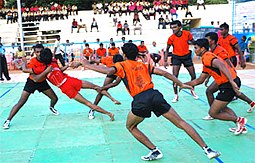Kabaddi: A Traditional Sport That Has Become Global
Kabaddi: A Traditional Sport That Has Become Global – Kabaddi is a traditional sport originating from South Asia and is very popular in countries such as India, Pakistan, Bangladesh, Sri Lanka and Nepal. The Game combines strategy, speed and physical strength, making it unique among other team sports.
Kabaddi’s Long History in South Asia
Kabaddi’s long history in South Asia reflects its close ties to the region’s culture and traditions. Kabaddi is believed to have been played for over 4,000 years, with early evidence found in ancient texts such as the Mahabharata. The epic depicts the strategy, strength and courage that are at the heart of the game of kabaddi.
The sport was originally played in rural areas as a physical and mental exercise, helping players improve their endurance, coordination and agility. It was also often used as a form of self-defense training, especially among ancient warriors.
Kabaddi’s popularity began to spread when it was played at a national level in India in the early 20th century. The first official tournaments were held in the 1920s, and standard rules were developed to ensure a more organised game. In the 1950s, the Indian Kabaddi Federation was formed, which played a major role in introducing the sport to the international arena.
Kabaddi was first officially recognized at the Asian Games in 1990. Since then, the sport has continued to gain global attention, attracting fans from many countries. Its popularity has soared with the advent of professional leagues such as the Pro Kabaddi League in India, which presents the game in a modern format and appeals to a younger audience.
To this day, kabaddi remains a symbol of South Asian cultural pride, not only as a sport but also as an important part of its rich historical heritage.
Basic Rules and Concept of Kabaddi Game
Basic Rules and Concept of Kabaddi Game is a combination of strategy, speed, and physical strength. In this game, two teams of seven players each face each other on a rectangular field. The main objective of the game is to score points by attacking the opposing team through a player called the raider.
Each team takes turns in attacking and defending. While attacking, the raider must enter the opponent’s territory, touch one or more opposing players, and return to his own zone without being caught. The main requirement for attacking is that the raider must keep saying the word “kabaddi” without stopping to breathe. If the raider manages to return to his territory after touching an opponent, his team will get a point.
On the other hand, the defending team tries to catch the raider by tackling or bringing him to the ground. If they succeed, the defending team gets a point. Also, any player who is knocked down is out of the game temporarily, and can only return if their team scores a point.
The game is played in two halves, each about 20 minutes long, with an interval in between. These rules keep the game fast and action-packed, with the team that is better at strategy and teamwork having a better chance of winning. Kabaddi is not just about physical strength, but also about intelligence in planning the game’s tactics.
Variations of Kabaddi in Different Countries
The variations of Kabaddi in different countries reflect the adaptation of the sport to local cultures and traditions. While the core of the game remains the same, there are differences in the rules and style of play that are applied in each country.
One of the most famous variations is Circle Style Kabaddi, which is widely played in the Punjab region of India and Pakistan. In this version, the game is played on a circular field, and the players involved focus more on the strategy of driving the opponent out of the playing area. In addition, the duration of each attack can be longer than other styles.
In India, another variation that is often played is Standard Style Kabaddi, which is an international format used in major events such as the Asian Games. In this format, the field is rectangular and the game is played with more stringent rules. This style emphasizes speed, accuracy and teamwork.
In countries such as Bangladesh and Sri Lanka, kabaddi is also played with slightly different rules, although the basic principles and strategies remain similar. Meanwhile, in several other countries, such as Japan and South Korea, kabaddi has begun to be adapted with adjustments to the rules to make it more attractive to local audiences.
In addition, there is Beach Kabaddi, which is played on the beach with more flexible rules and a smaller field. This version is more relaxed and less intense, but still relies on the agility and physical strength of the players.
What Makes Kabaddi Different from Other Sports
What makes kabaddi different from other sports is its combination of intense physical, mental, and strategic elements. Unlike many other team sports, kabaddi requires players to work quickly and intelligently in very limited situations. One of the most distinctive aspects of the game is the requirement for a raider to continuously say the word “kabaddi” while attacking without stopping for breath. This adds to the physical challenge as players must catch their breath and maintain their energy during the attack.
In addition, kabaddi is played without any sports equipment, relying solely on the players’ bodies. Players must master a variety of physical skills, such as agility, strength, and endurance. In this game, offense and defense alternate, with the defending team trying to catch the opposing raider who tries to touch them.
Another aspect that makes kabaddi unique is how players switch roles between offense and defense at the same time. This requires them to have a deep understanding of tactics and the ability to adapt quickly. The strategy used in kabaddi relies heavily on solid teamwork, with each player having to function as part of a larger system.
Another uniqueness is how kabaddi maintains its simplicity despite its development as an international sport. With minimal rules and utilizing simple fields, kabaddi can still be played in various places, from villages to large stadiums.




